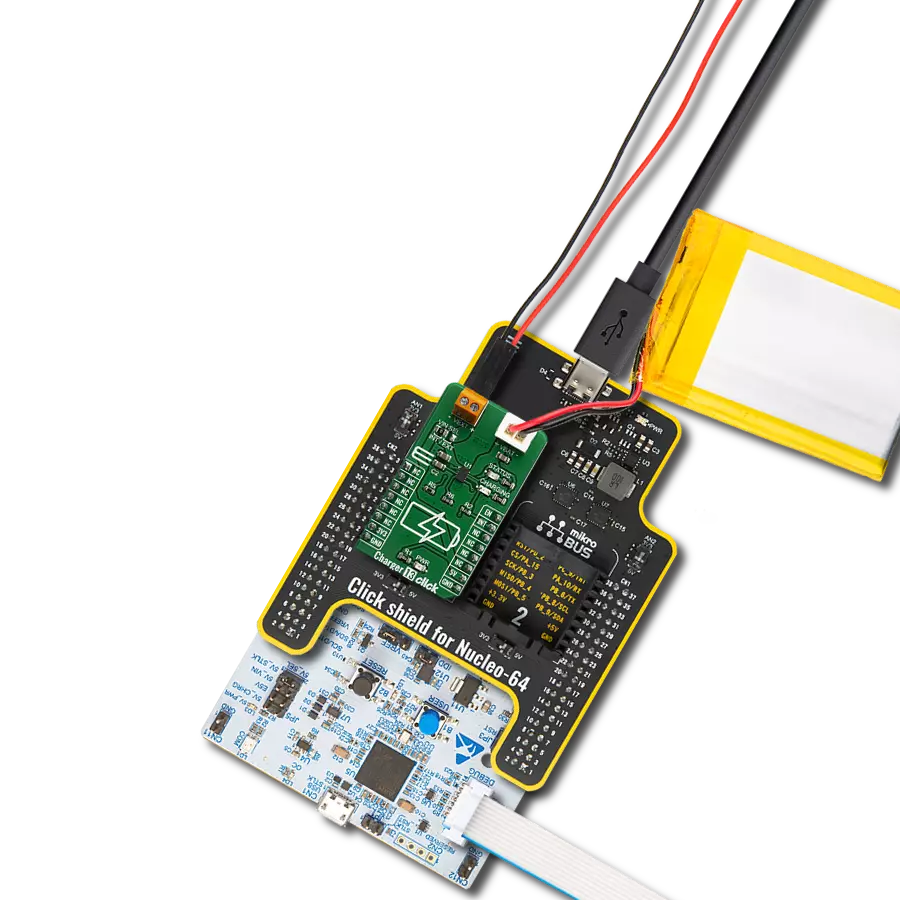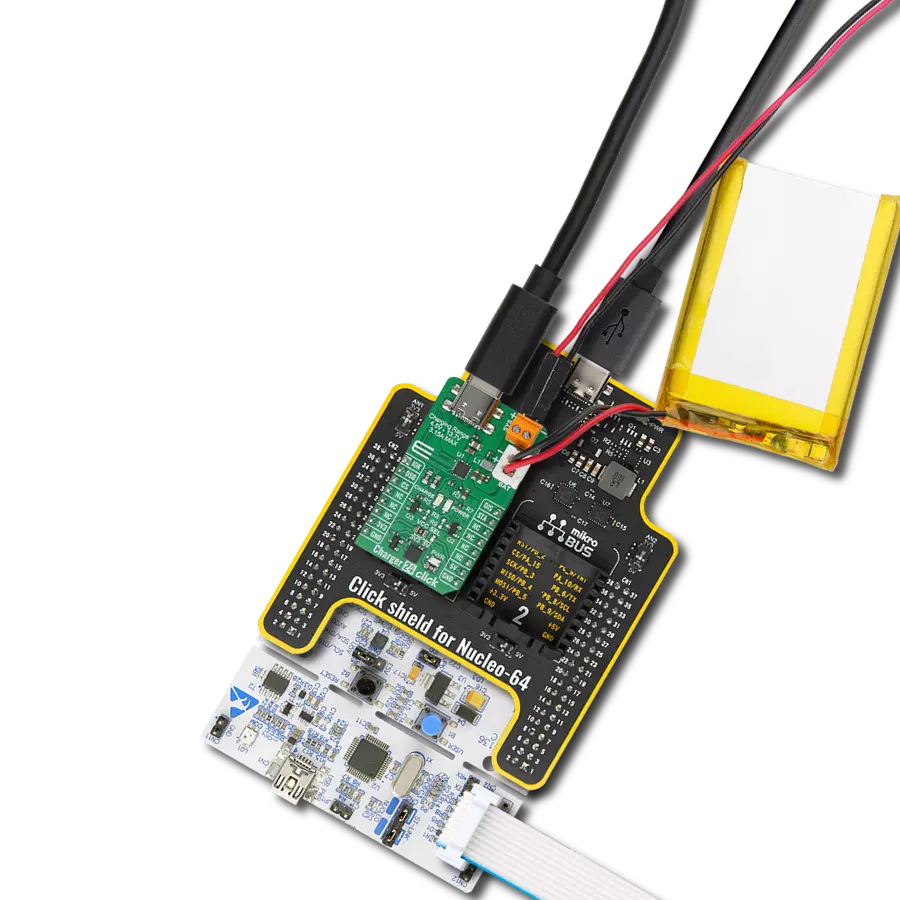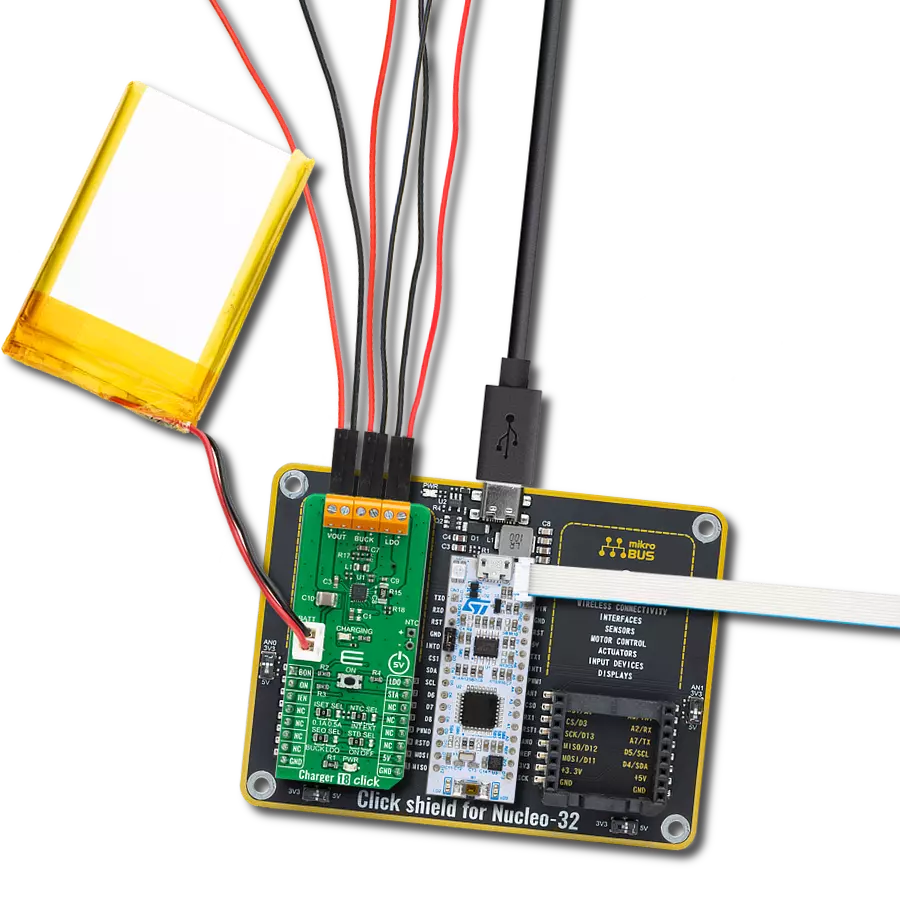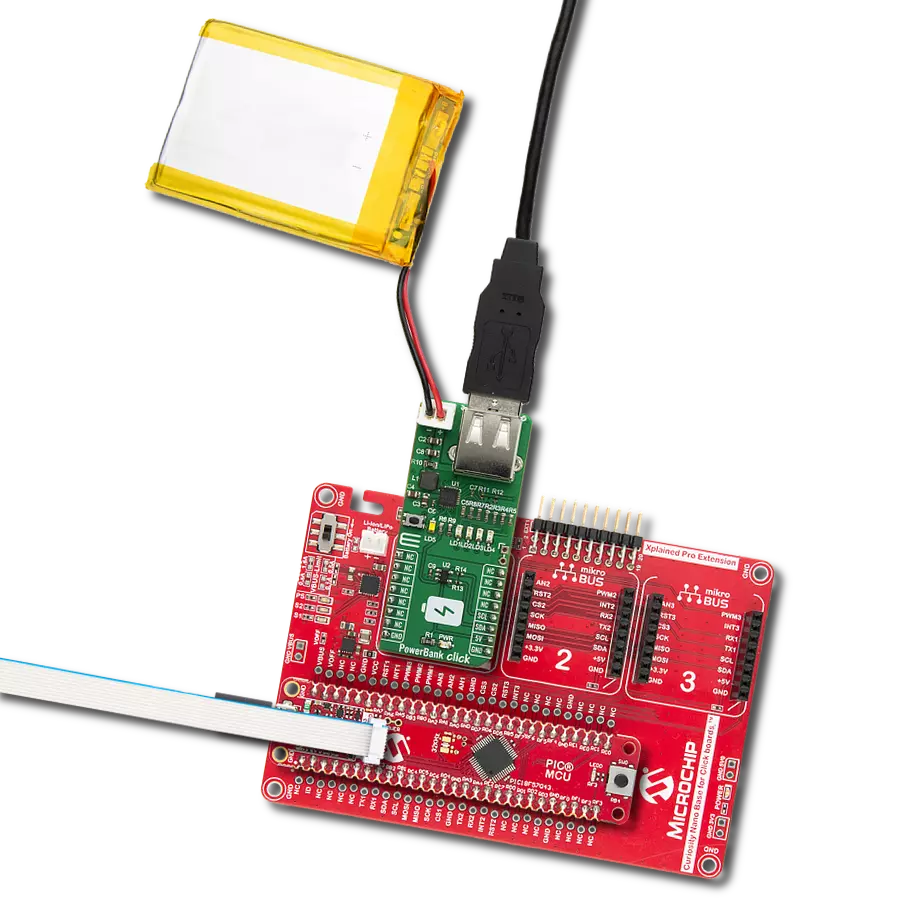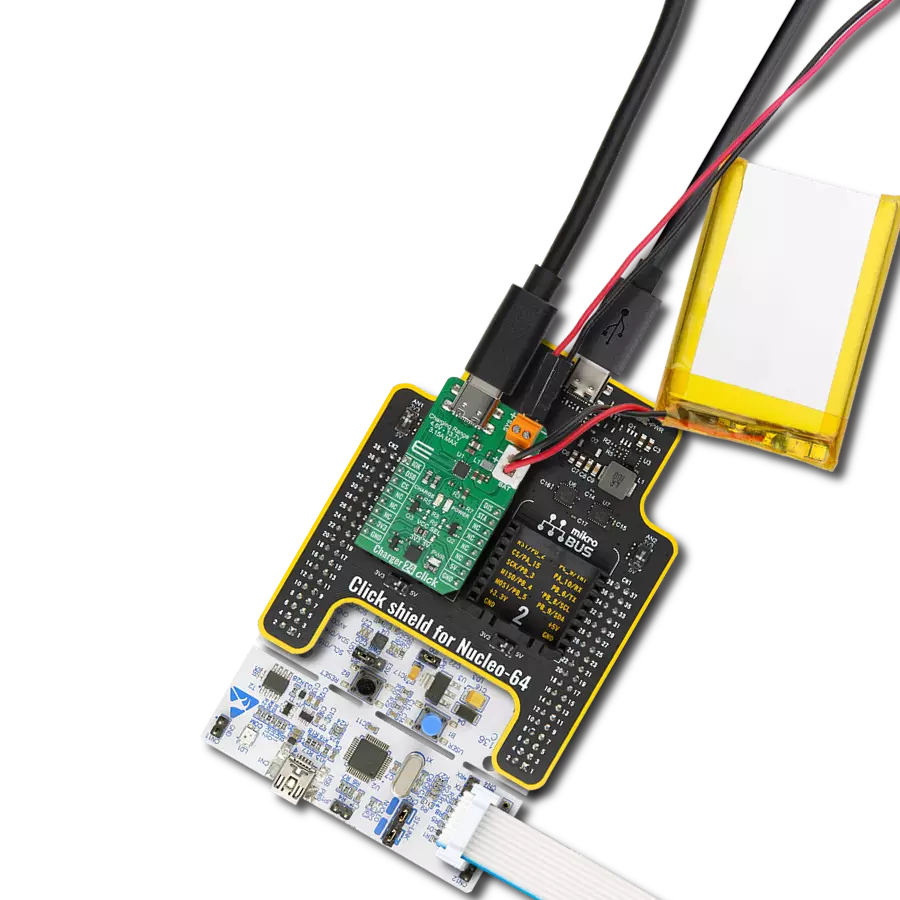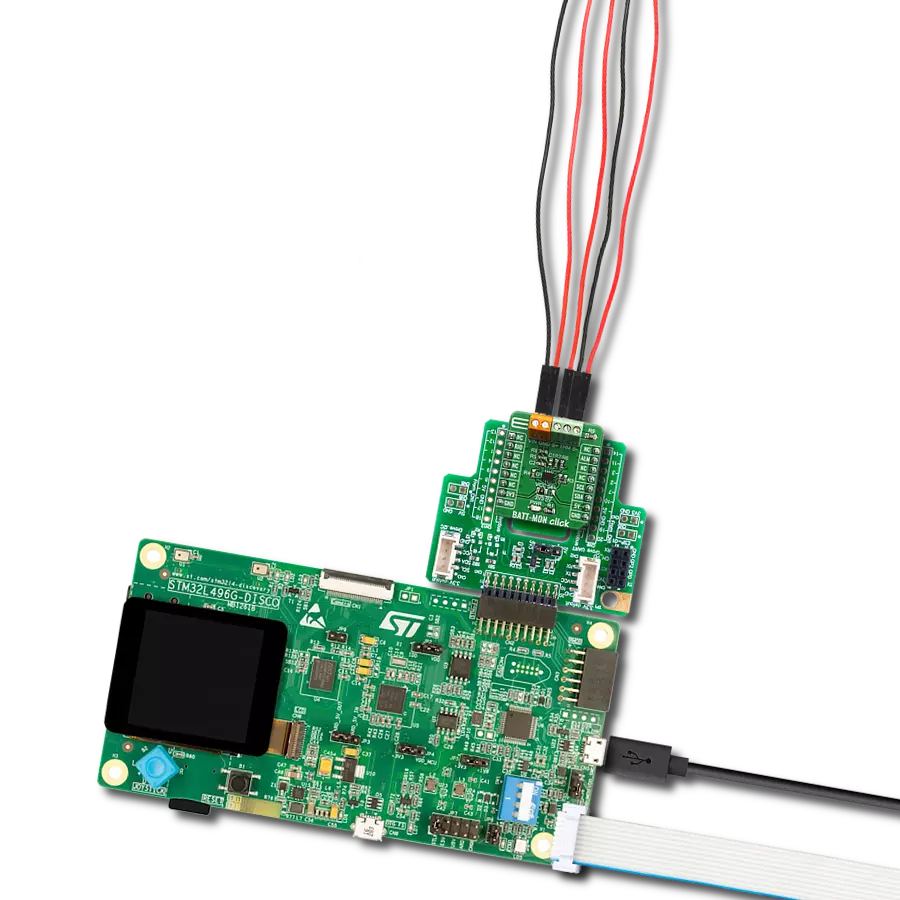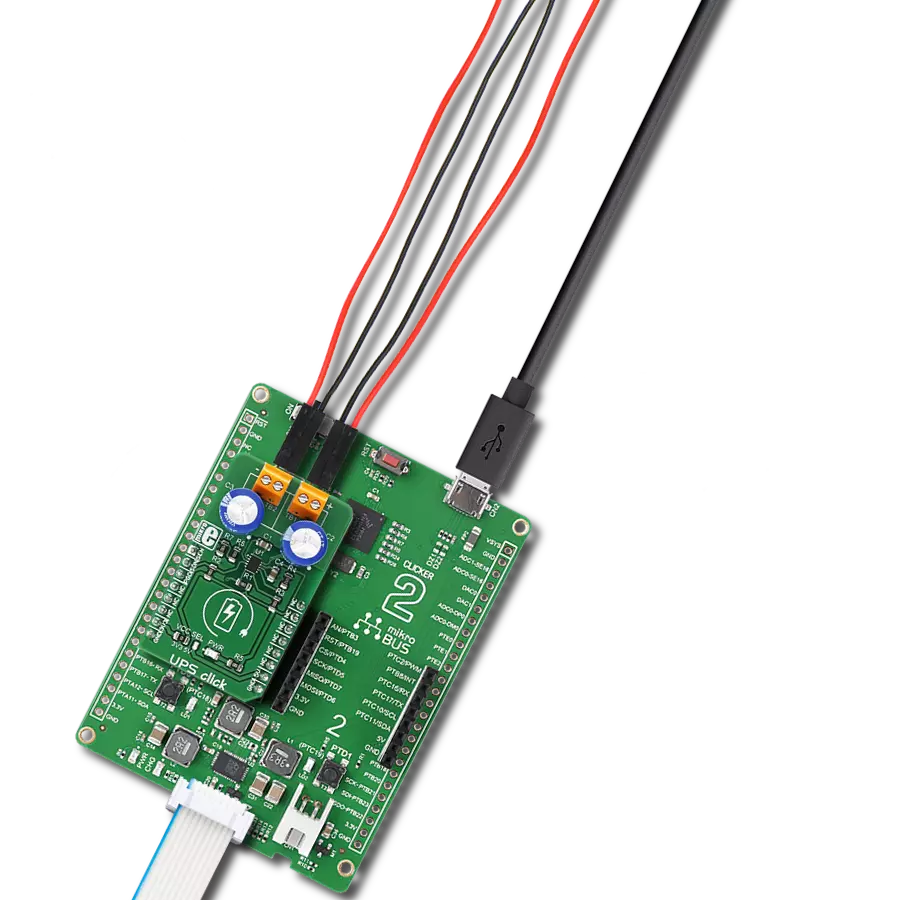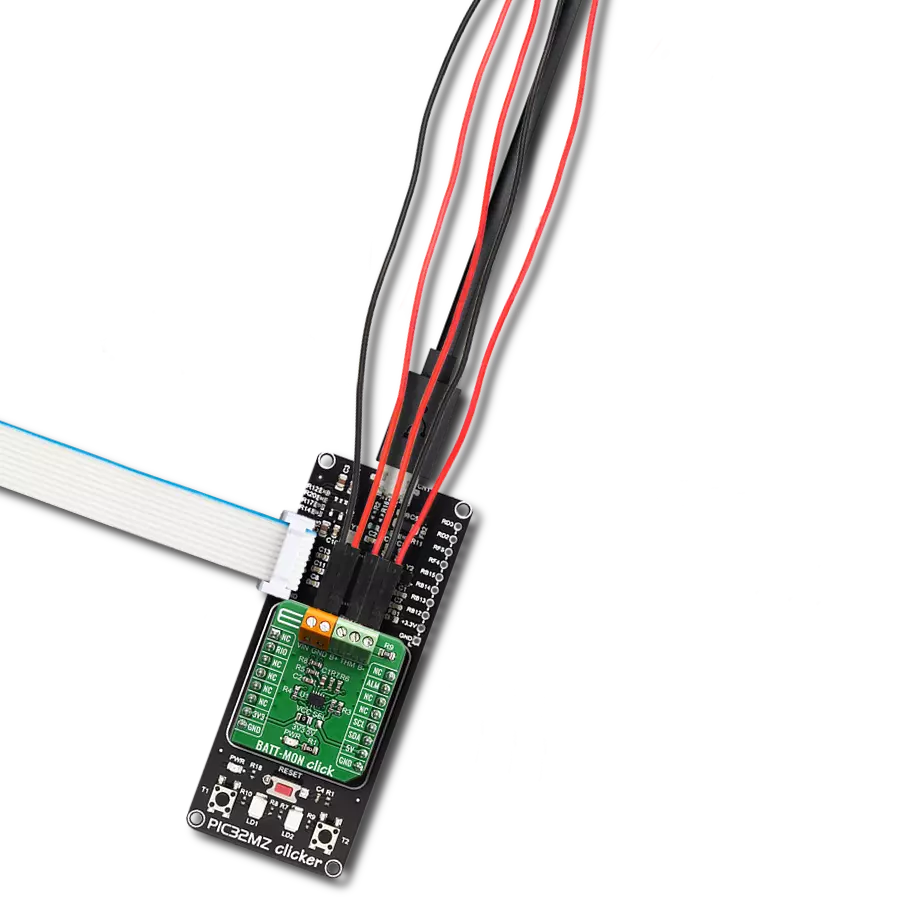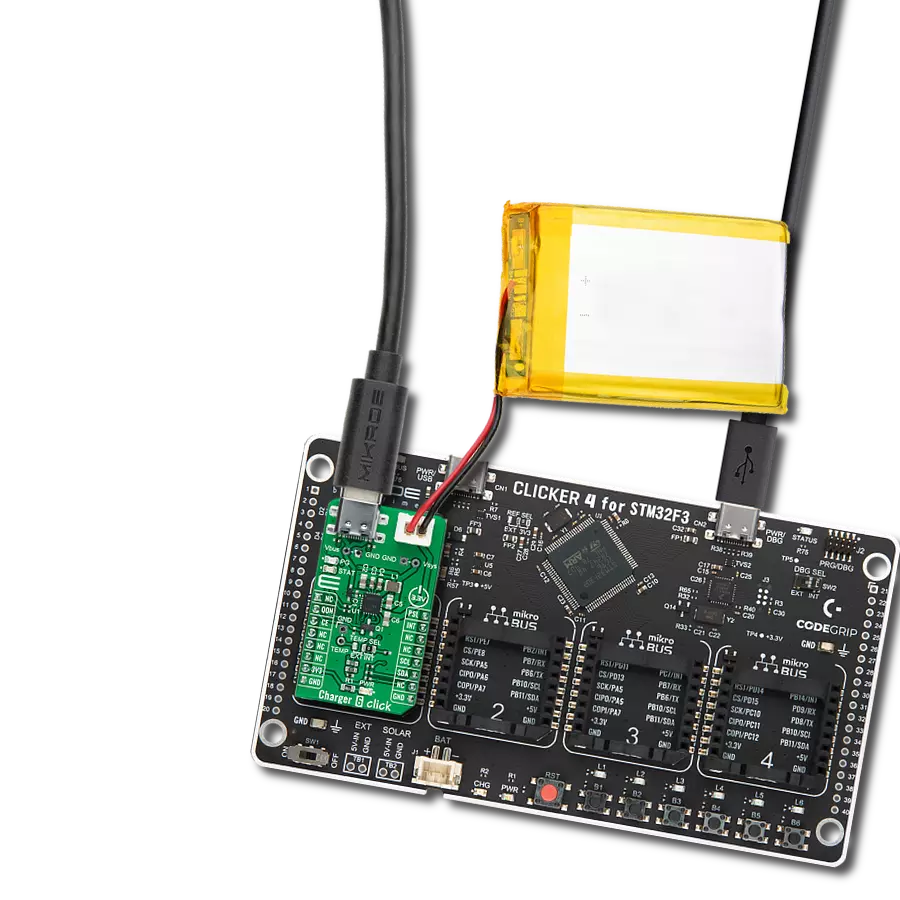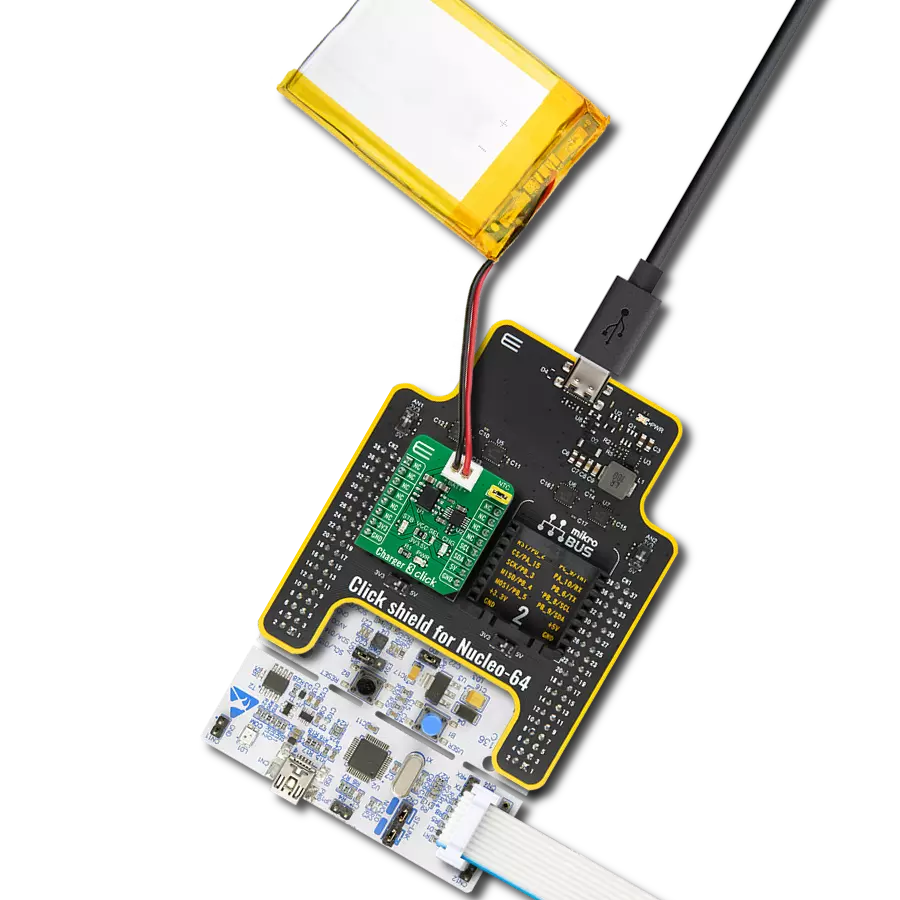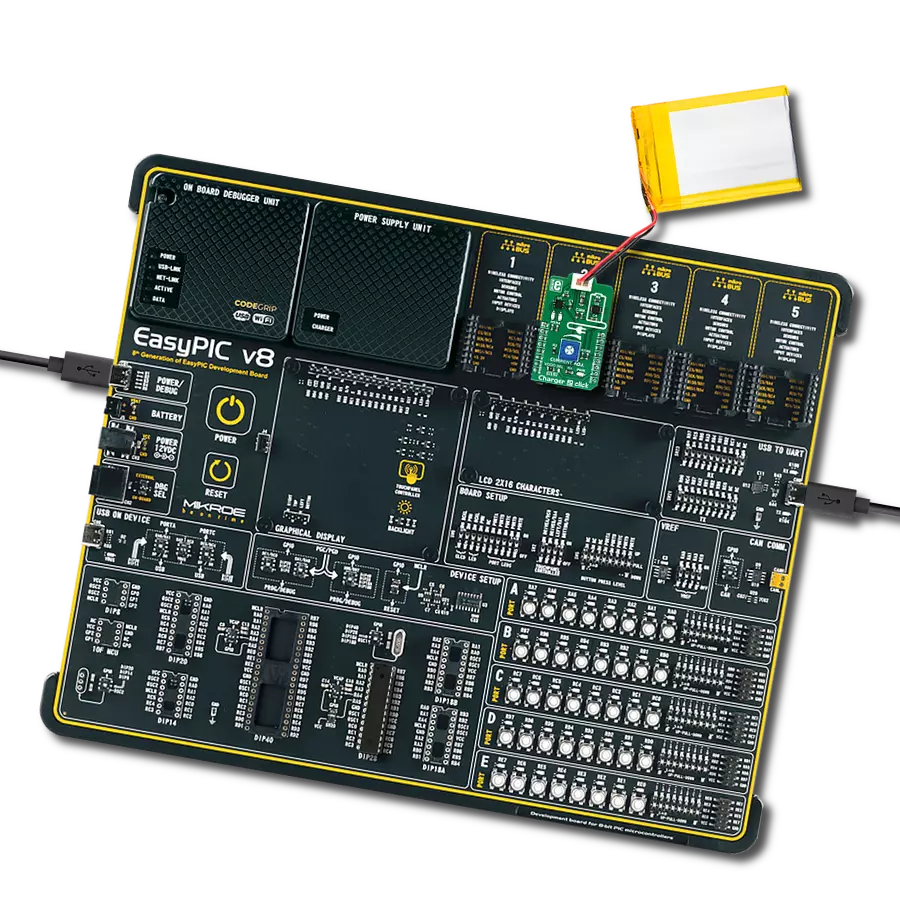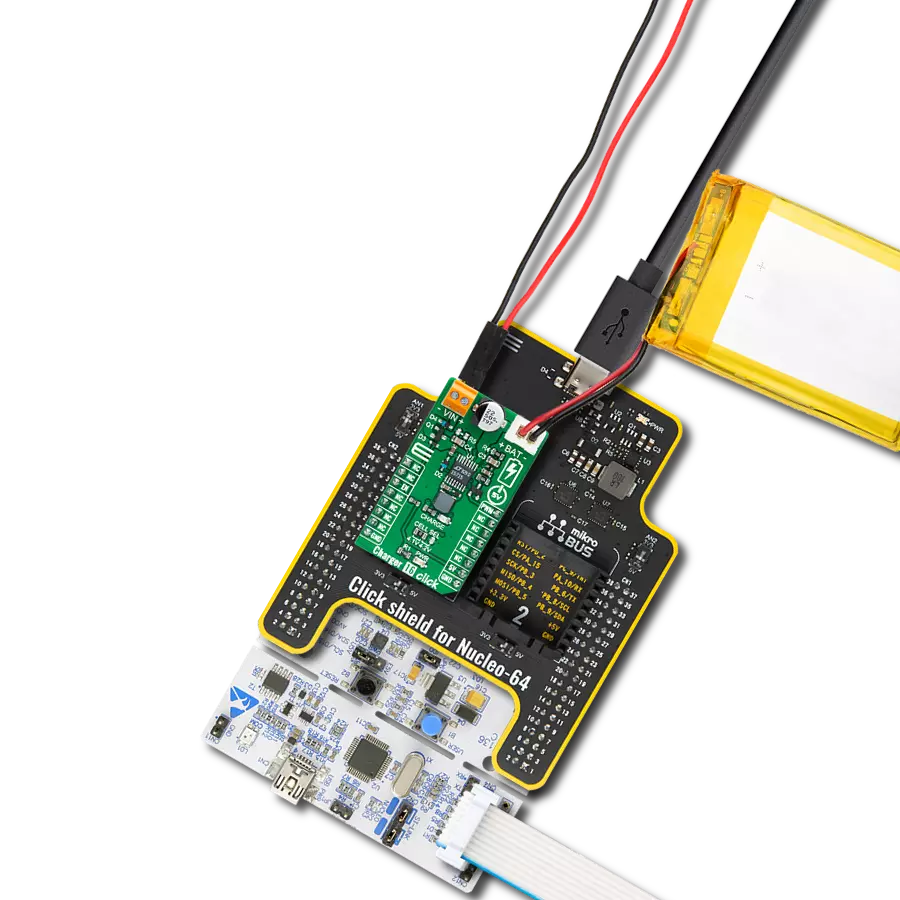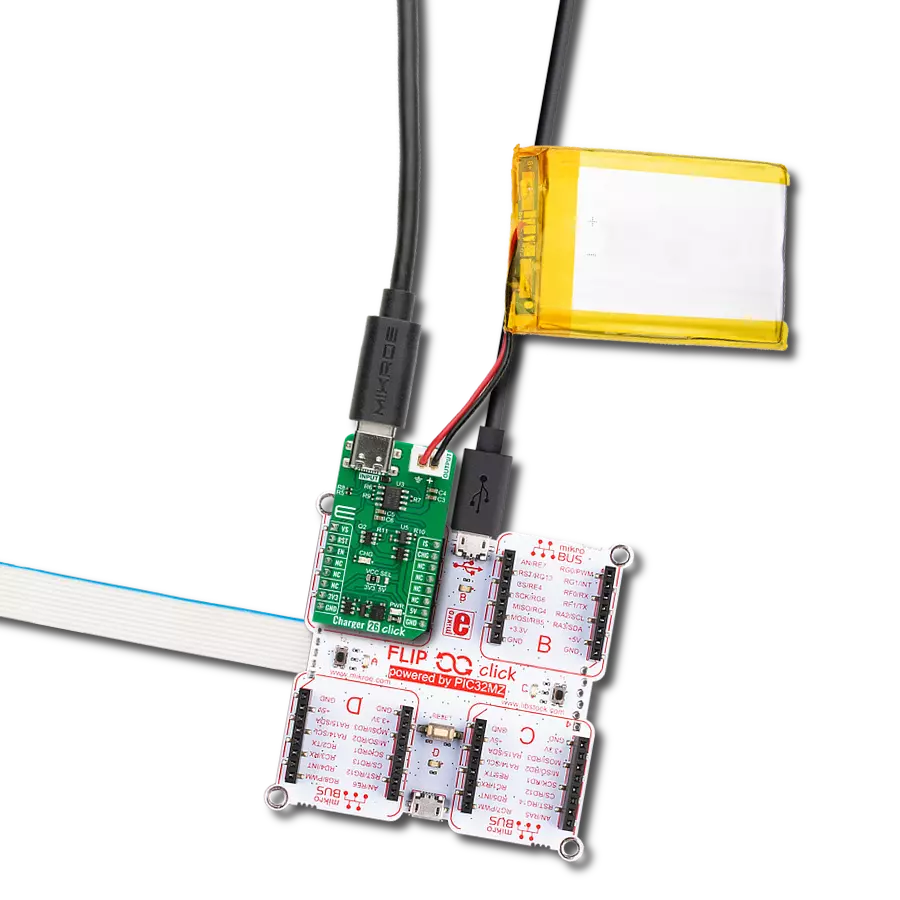Power up your portable devices with an advanced single-cell Li-Ion or Li-Polymer switching charger, designed for a wide input range and on-the-go applications
A
A
Hardware Overview
How does it work?
Charger 27 Click is based on the MP2639B, a Li-Ion or Li-Polymer switching charger from MPS. The charger works in three modes: charge, discharge, and sleep mode. It operates as a switching charger if the input power supply is available. The charger automatically detects the battery voltage and charges the battery in three phases: pre-charge, constant charge, and constant voltage charge. Other features include charge termination and auto-recharge. When the input is absent, the charger can provide a boost voltage to the VIN terminal, the same which is used for the input voltage power supply. This Click board™ uses a
general-purpose I/O to allow the host MCU to control the MP2639B charger. Besides the push button, you can also select charge mode by pulling the MD pin to a LOW logic state and discharge mode by pulling this pin to a HIGH logic state. The charger uses the CHG pin to indicate the host MCU of the charge status and the AOK pin to indicate the valid input supply. There are several LEDs on the Charger 27 Click. LEDs labeled 1 – 4 represent a fuel gauge. The charge completion indicator is available over the CHG LED, and the valid input supply indicator is available over the AOK LED. The discharge function is enabled by pressing the
onboard button for less than 2.5 seconds. If the discharge is enabled, you can turn off this feature by pressing the button longer than 2.5 seconds. You can also set the charge current between 1A and 2A over the ISET SEL jumper. This Click board™ can operate with either 3.3V or 5V logic voltage levels selected via the VCC SEL jumper. This way, both 3.3V and 5V capable MCUs can use the communication lines properly. Also, this Click board™ comes equipped with a library containing easy-to-use functions and an example code that can be used as a reference for further development.
Features overview
Development board
6LoWPAN Clicker is a compact starter development board that brings the flexibility of add-on Click boards™ to your favorite microcontroller, making it a perfect starter kit for implementing your ideas. It comes with an onboard 32-bit PIC microcontroller, the PIC32MX470F512H from Microchip, a USB connector, LED indicators, buttons, a mikroProg connector, and a header for interfacing with external electronics. Along with this microcontroller, the board also contains a 2.4GHz ISM band transceiver, allowing you to add wireless communication to your target application. Its compact design provides a fluid and immersive working experience, allowing access anywhere
and under any circumstances. Each part of the 6LoWPAN Clicker development kit contains the components necessary for the most efficient operation of the same board. In addition to the possibility of choosing the 6LoWPAN Clicker programming method, using USB HID mikroBootloader, or through an external mikroProg connector for PIC, dsPIC, or PIC32 programmer, the Clicker board also includes a clean and regulated power supply module for the development kit. The USB Micro-B connection can provide up to 500mA of current for the Clicker board, which is more than enough to operate all onboard and additional modules, or it can power
over two standard AA batteries. All communication methods that mikroBUS™ itself supports are on this board, including the well-established mikroBUS™ socket, reset button, and several buttons and LED indicators. 6LoWPAN Clicker is an integral part of the Mikroe ecosystem, allowing you to create a new application in minutes. Natively supported by Mikroe software tools, it covers many aspects of prototyping thanks to a considerable number of different Click boards™ (over a thousand boards), the number of which is growing every day.
Microcontroller Overview
MCU Card / MCU
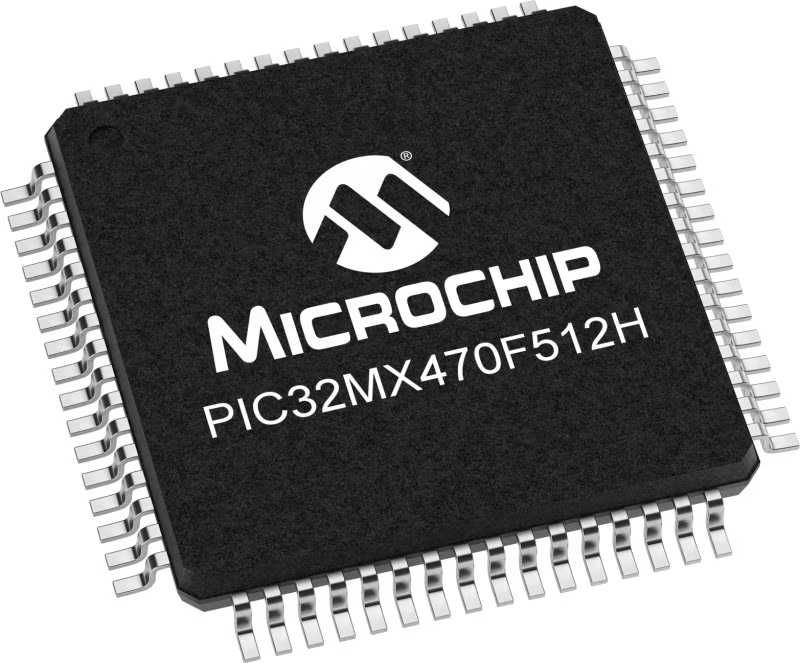
Architecture
PIC32
MCU Memory (KB)
512
Silicon Vendor
Microchip
Pin count
64
RAM (Bytes)
131072
You complete me!
Accessories
Li-Polymer Battery is the ideal solution for devices that demand a dependable and long-lasting power supply while emphasizing mobility. Its compatibility with mikromedia boards ensures easy integration without additional modifications. With a voltage output of 3.7V, the battery meets the standard requirements of many electronic devices. Additionally, boasting a capacity of 2000mAh, it can store a substantial amount of energy, providing sustained power for extended periods. This feature minimizes the need for frequent recharging or replacement. Overall, the Li-Polymer Battery is a reliable and autonomous power source, ideally suited for devices requiring a stable and enduring energy solution. You can find a more extensive choice of Li-Polymer batteries in our offer.
Used MCU Pins
mikroBUS™ mapper
Take a closer look
Click board™ Schematic

Step by step
Project assembly
Software Support
Library Description
This library contains API for Charger 27 Click driver.
Key functions:
charger27_set_mode- This function is used for the charge or discharge mode selectioncharger27_check_chg_completion- This function checks the charging completion indicator statecharger27_check_input_supply- This function checks valid input supply indicator state
Open Source
Code example
The complete application code and a ready-to-use project are available through the NECTO Studio Package Manager for direct installation in the NECTO Studio. The application code can also be found on the MIKROE GitHub account.
/*!
* @file main.c
* @brief Charger 27 Click Example.
*
* # Description
* This example demonstrates the use of the Charger 27 Click board
* by enabling charge or discharge mode and
* indicating valid input supply and charging completion.
*
* The demo application is composed of two sections :
*
* ## Application Init
* Initialization of GPIO module and log UART.
* After driver initialization, the app sets charge mode.
*
* ## Application Task
* The Charger 27 Click board operates as a switching charger to charge a 1S battery
* from a wide input power range of 5V to 16V, which can cover a USB PD voltage level.
* The demo application checks and displays the charging completion indicator status.
* Results are being sent to the UART Terminal, where you can track their changes.
*
* @author Nenad Filipovic
*
*/
#include "board.h"
#include "log.h"
#include "charger27.h"
static charger27_t charger27; /**< Charger 27 Click driver object. */
static log_t logger; /**< Logger object. */
void application_init ( void )
{
log_cfg_t log_cfg; /**< Logger config object. */
charger27_cfg_t charger27_cfg; /**< Click config object. */
/**
* Logger initialization.
* Default baud rate: 115200
* Default log level: LOG_LEVEL_DEBUG
* @note If USB_UART_RX and USB_UART_TX
* are defined as HAL_PIN_NC, you will
* need to define them manually for log to work.
* See @b LOG_MAP_USB_UART macro definition for detailed explanation.
*/
LOG_MAP_USB_UART( log_cfg );
log_init( &logger, &log_cfg );
log_info( &logger, " Application Init " );
// Click initialization.
charger27_cfg_setup( &charger27_cfg );
CHARGER27_MAP_MIKROBUS( charger27_cfg, MIKROBUS_1 );
if ( DIGITAL_OUT_UNSUPPORTED_PIN == charger27_init( &charger27, &charger27_cfg ) )
{
log_error( &logger, " Communication init." );
for ( ; ; );
}
if ( CHARGER27_OK == charger27_set_mode( &charger27, CHARGER27_MODE_CHARGE ) )
{
log_printf( &logger, " > Charge mode <\r\n" );
Delay_ms ( 100 );
}
}
void application_task ( void )
{
if ( CHARGER27_CHG_CHARGE == charger27_check_chg_completion( &charger27 ) )
{
log_printf( &logger, " Charging.\r\n" );
Delay_ms ( 1000 );
}
else
{
log_printf( &logger, " Charging has completed or is suspended.\r\n" );
Delay_ms ( 1000 );
}
}
int main ( void )
{
/* Do not remove this line or clock might not be set correctly. */
#ifdef PREINIT_SUPPORTED
preinit();
#endif
application_init( );
for ( ; ; )
{
application_task( );
}
return 0;
}
// ------------------------------------------------------------------------ END
Additional Support
Resources
Category:Battery charger



















